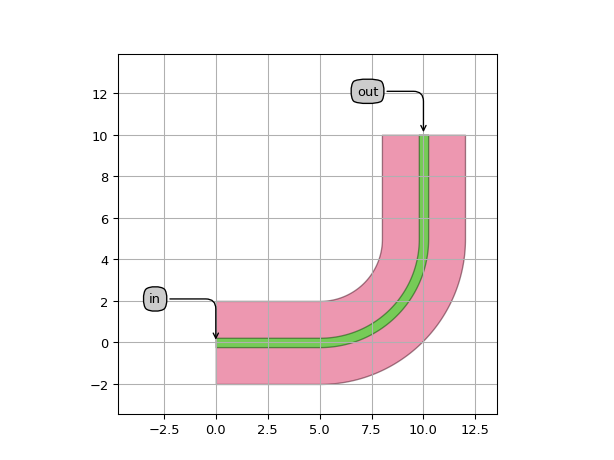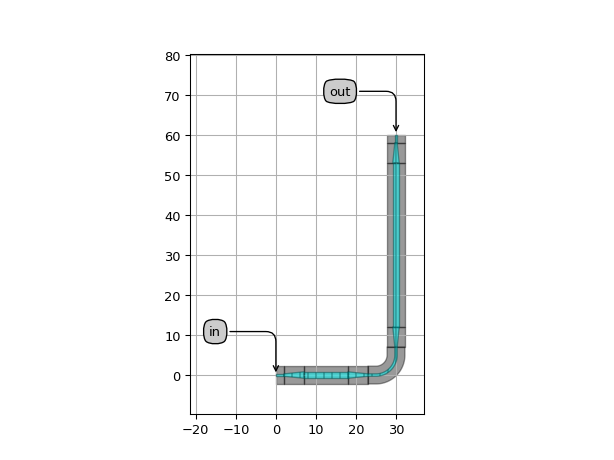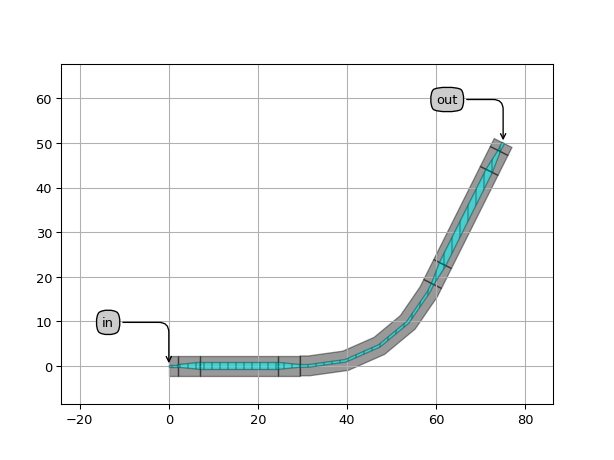Optical waveguides and waveguide templates
In IPKISS, optical waveguides are based on two concepts: the waveguide template, and the waveguide itself. The waveguide template defines all the aspects of the waveguide that can be extracted from its cross section:
how the waveguide is drawn along the shape of the waveguide, i.e. the geometrical cross section;
the simulation model, e.g. the effective index of the waveguide.
The waveguide is then drawn based on the following properties:
the path of the waveguide (through the
shapeproperty);how the bending is performed.
For a detailed guide, please check the waveguide guide. For a tutorial, please check out the waveguide tutorial on Luceda Academy.
WindowWaveguideTemplate
Most waveguides can be built using windows. A window is a cross-section in a gdsii layer. By defining several windows the cross section of the waveguide can be defined.
- class ipkiss3.all.WindowWaveguideTemplate
Template PCell for an Optical Waveguide Trace based on TraceWindows.
- Parameters:
- name: String that contains only ISO/IEC 8859-1 (extended ASCII py3) or pure ASCII (py2) characters
The unique name of the pcell
Views
- class Layout
- Parameters:
- windows: List with type restriction, allowed types: <class ‘ipkiss3.pcell.trace.window.window._TraceWindow’>
List of Trace Windows that know how to draw themselves relative to the shape of the Trace
- core_width: float and number > 0
width of the waveguide core
- core_layer: __Layer__
layer used to define the core of the waveguide
- pin_shape: Shape
shape to be used for the pins
- trace_template_for_ports: _TraceTemplate.Layout
Trace template to be used for the ports. Default = this template
- width: float and Real, number and number >= 0
- control_shape_layer: __Layer__
layer on which the control shape is drawn
- draw_control_shape: ( bool, bool_ or int )
draws the control shape on top of the waveguide
- cover_layers: List with type restriction, allowed types: <class ‘ipkiss.primitives.layer.Layer’>
layers that can be used to generate additional coverage of the trace (e.g. manhattan corners)
- view_name: String that contains only alphanumeric characters from the ASCII set or contains _$. ASCII set is extended on PY3.
The name of the view
Examples
import si_fab.all as pdk # noqa: F401 import ipkiss3.all as i3 class MyWgTemplate(i3.WindowWaveguideTemplate): class Layout(i3.WindowWaveguideTemplate.Layout): core_width = i3.PositiveNumberProperty(doc="Core width of the waveguide") cladding_width = i3.PositiveNumberProperty(doc="Cladding width of the waveguide") def _default_core_width(self): return 0.45 def _default_cladding_width(self): return 4.0 def _default_cover_layers(self): # Layer for Manhattan rectangles # (drawn in waveguide bends when the waveguide manhattan parameter = True) return [] def _default_windows(self): return [ i3.PathTraceWindow( layer=i3.TECH.PPLAYER.SI, start_offset=-0.5 * self.core_width, end_offset=+0.5 * self.core_width, ), i3.PathTraceWindow( layer=i3.TECH.PPLAYER.SI_CLADDING, start_offset=-0.5 * self.cladding_width, end_offset=+0.5 * self.cladding_width, ), ] # Instantiate the new waveguide template to use it in our waveguide below wg_tmpl = MyWgTemplate() wg = i3.RoundedWaveguide(trace_template=wg_tmpl) wg_lay = wg.Layout(shape=[(0, 0), (10, 0), (10, 10)]) wg_lay.visualize(annotate=True)

- .
# for now disabled: .. autoattribute:: Netlist
TraceTemplate
Simple trace template for drawing waveguides.
- class ipkiss3.all.TraceTemplate
Template for a Basic Trace on a chip.
- Parameters:
- name: String that contains only ISO/IEC 8859-1 (extended ASCII py3) or pure ASCII (py2) characters
The unique name of the pcell
Views
- class Layout
- Parameters:
- layer: __Layer__
- control_shape_layer: __Layer__
layer on which the control shape is drawn
- draw_control_shape: ( bool, bool_ or int )
draws the control shape on top of the waveguide
- width: float and Real, number and number >= 0
- view_name: String that contains only alphanumeric characters from the ASCII set or contains _$. ASCII set is extended on PY3.
The name of the view
Waveguide
A Waveguide is the most basic optical route.
- class ipkiss3.all.Waveguide
- Parameters:
- trace_template: PCell and _WaveguideTemplate
- external_port_names: str
Dictionary for remapping of the port names of the contents to the external ports
- name: String that contains only ISO/IEC 8859-1 (extended ASCII py3) or pure ASCII (py2) characters
The unique name of the pcell
- Other Parameters:
- contents: PCell and _Trace, locked
Views
- class Layout
- Parameters:
- core_layer: __Layer__
layer used to define the core of the waveguide
- input_port: TracePort
- trace_template_for_ports: _TraceTemplate.Layout
Trace template to be used for the ports.
- shape: Shape
Shape from which the Trace is calculated
- cover_layers: List with type restriction, allowed types: <class ‘ipkiss.primitives.layer.Layer’>
layers that can be used to generate additional coverage of the trace (e.g. manhattan corners)
- control_shape_layer: __Layer__
layer on which the control shape is drawn
- output_port: TracePort
- draw_control_shape: ( bool, bool_ or int )
draws the control shape on top of the waveguide
- contents_transformation: GenericNoDistortTransform
- flatten_contents: ( bool, bool_ or int )
if True, it will insert the contents as elements in the layout, rather than as an Instance
- view_name: String that contains only alphanumeric characters from the ASCII set or contains _$. ASCII set is extended on PY3.
The name of the view
- Other Parameters:
- center_line_shape: locked
Automatically calculated shape of the center line of the trace
RoundedWaveguide
A RoundedWaveguide rounds the waveguide according to a preset rounding_algorithm.
- class ipkiss3.all.RoundedWaveguide
- Parameters:
- trace_template: PCell and _WaveguideTemplate
- external_port_names: str
Dictionary for remapping of the port names of the contents to the external ports
- name: String that contains only ISO/IEC 8859-1 (extended ASCII py3) or pure ASCII (py2) characters
The unique name of the pcell
- Other Parameters:
- contents: PCell and _Trace, locked
Views
- class Layout
- Parameters:
- output_port: TracePort
- trace_template_for_ports: _TraceTemplate.Layout
Trace template to be used for the ports.
- shape: Shape
Shape from which the Trace is calculated
- cover_layers: List with type restriction, allowed types: <class ‘ipkiss.primitives.layer.Layer’>
layers that can be used to generate additional coverage of the trace (e.g. manhattan corners)
- reverse_individual_bends: list<( bool, bool_ or int )>
When set to True, it will generate the individual bends backwards. This has only effect when the bend algorithm is not symmetric. Should have length equal to the shape for closed shapes, but equal to shape-2 for open shapes.
- rounding_algorithms:
Rounding algorithm for every individual bend. Can be circular, spline, … Should have length equal to the shape for closed shapes, but equal to shape-2 for open shapes.
- bend_radii: list<number > 0>
Bend radius for every individual bend.
- reverse_bends: ( bool, bool_ or int )
When set to True, it will generate the bends backwards. This has only effect when the bend algorithm is not symmetric.
- remove_straight_angles: ( bool, bool_ or int )
Removes the waypoints with straight angles. Set to False if the algorithm uses waypoint-specific information.
- core_layer: __Layer__
layer used to define the core of the waveguide
- input_port: TracePort
- control_shape_layer: __Layer__
layer on which the control shape is drawn
- draw_control_shape: ( bool, bool_ or int )
draws the control shape on top of the waveguide
- contents_transformation: GenericNoDistortTransform
- flatten_contents: ( bool, bool_ or int )
if True, it will insert the contents as elements in the layout, rather than as an Instance
- view_name: String that contains only alphanumeric characters from the ASCII set or contains _$. ASCII set is extended on PY3.
The name of the view
- manhattan: ( bool, bool_ or int )
Adds rectangular blocks in the bends to avoid as much as possible non-manhattan angles.
- angle_step: float and number > 0
Angle step for rounding.
- rounding_algorithm:
Rounding algorithm used to generate the bends. Can be circular, spline, ….
- bend_radius: float and number > 0
Bend radius for the auto-generated bends.
- Other Parameters:
- center_line_shape: locked
Automatically calculated shape of the center line of the trace
TaperedWaveguide
A TaperedWaveguide automatically tapers between two waveguide templates:
one which is defined for the straight sections (straight_trace_template),
and one which is defined for the start, end and bend sections (trace_template).
- class ipkiss3.all.TaperedWaveguide
A Rounded Waveguide that tapers to another template (
straight_trace_template) in straight sections- Parameters:
- fixed_bend90: ( PCell ), *None allowed*
PCell used for the 90 degree bends in the route. The angle should be a 90 degree bend and have exactly two optical ports. The trace template of the bend should match trace_template. Bends are assumed to be bi-directional in the routing.
- straight_trace_template: PCell and _TraceTemplate
template for the straight sections.
- trace_template: PCell and _TraceTemplate
template for the start, end and bend sections.
- external_port_names: str
Dictionary for remapping of the port names of the contents to the external ports
- name: String that contains only ISO/IEC 8859-1 (extended ASCII py3) or pure ASCII (py2) characters
The unique name of the pcell
- Other Parameters:
- contents: PCell and _Trace, locked
Examples
"""A TaperedWaveguide automatically transitions (=tapers) between different waveguide types.""" import si_fab.all as pdk # noqa: F401 import ipkiss3.all as i3 from picazzo3.traces.rib_wg import RibWaveguideTemplate rib_tmpl = RibWaveguideTemplate() rib_tmpl.Layout(core_width=0.6) rib_tmpl_wide = RibWaveguideTemplate() rib_tmpl_wide.Layout(core_width=1.6) twg = i3.TaperedWaveguide(trace_template=rib_tmpl, straight_trace_template=rib_tmpl_wide) lay = twg.Layout(shape=[(0, 0), (30, 0), (30, 60)]) lay.visualize(annotate=True)

"""TaperedWaveguide exposes the same properties as RoundedWaveguide.""" import si_fab.all as pdk # noqa: F401 import ipkiss3.all as i3 from picazzo3.traces.rib_wg import RibWaveguideTemplate rib_tmpl = RibWaveguideTemplate() rib_tmpl.Layout(core_width=0.6) rib_tmpl_wide = RibWaveguideTemplate() rib_tmpl_wide.Layout(core_width=1.6) twg = i3.TaperedWaveguide(trace_template=rib_tmpl, straight_trace_template=rib_tmpl_wide) lay = twg.Layout( shape=[(0, 0), (50, 0), (75, 50)], bend_radius=30, # we choose a large angle_step to show how it impacts the discretisation angle_step=20, ) lay.visualize(annotate=True)

Views
- class Layout
- Parameters:
- taper_lengths: list<number >= 0>
Lengths of the tapers for each section. Length of list must be identical to number of segments.
- straight_section_positions: list<fraction>
A list of relative positions for the straight_template sections of each path segment. Length of list must be identical to number of segments.Each position is a number between 0 (closest to first waypoint) and 1 (closest to last waypoint).0.5 will place the expanded section in the middle of the segment.
- straight_section_lengths: list<number >= 0>
A list of lengths for the straight_template sections of each path segment.Length of list must be identical to number of segments
- flatten_waveguides: ( bool, bool_ or int )
If true, all waveguides will be flattened one level to reduce hierarchy
- taper_length: ( float and number > 0 ), *None allowed*
length of the taper between the regular waveguide and the expanded waveguide. Ignored if taper_lengths is set. If
None, the default taper lengths for each transition are chosen for each transition.- draw_control_shape: ( bool, bool_ or int )
draws the control shape on top of the waveguide
- contents_transformation: GenericNoDistortTransform
- flatten_contents: ( bool, bool_ or int )
if True, it will insert the contents as elements in the layout, rather than as an Instance
- output_port: TracePort
- trace_template_for_ports: _TraceTemplate.Layout
Trace template to be used for the ports.
- shape: Shape
Shape from which the Trace is calculated
- cover_layers: List with type restriction, allowed types: <class ‘ipkiss.primitives.layer.Layer’>
layers that can be used to generate additional coverage of the trace (e.g. manhattan corners)
- reverse_individual_bends: list<( bool, bool_ or int )>
When set to True, it will generate the individual bends backwards. This has only effect when the bend algorithm is not symmetric. Should have length equal to the shape for closed shapes, but equal to shape-2 for open shapes.
- rounding_algorithms:
Rounding algorithm for every individual bend. Can be circular, spline, … Should have length equal to the shape for closed shapes, but equal to shape-2 for open shapes.
- bend_radii: list<number > 0>
Bend radius for every individual bend.
- reverse_bends: ( bool, bool_ or int )
When set to True, it will generate the bends backwards. This has only effect when the bend algorithm is not symmetric.
- remove_straight_angles: ( ( bool, bool_ or int ) ), *None allowed*
Remove waypoints with straight angles. When set to None, it will only remove straight angles when all the expansion parameters are calculated automatically
- core_layer: __Layer__
layer used to define the core of the waveguide
- input_port: TracePort
- min_straight: float and Real, number and number >= 0
The minimum length of any straight sections in the route
- control_shape_layer: __Layer__
layer on which the control shape is drawn
- min_straight_section_length: float and Real, number and number >= 0
minimum_length of the straight sections.
- view_name: String that contains only alphanumeric characters from the ASCII set or contains _$. ASCII set is extended on PY3.
The name of the view
- start_straight: float and Real, number and number >= 0
The length of the straight start section of the route
- end_straight: float and Real, number and number >= 0
The length of the straight end section of the route
- manhattan: ( bool, bool_ or int )
Adds rectangular blocks in the bends to avoid as much as possible non-manhattan angles.
- angle_step: float and number > 0
Angle step for rounding.
- rounding_algorithm: *None allowed*
rounding algorithm used to generate the bends. Can be circular, spline, …
- bend_radius: float and number > 0
Bend radius for the auto-generated bends.
- Other Parameters:
- min_length_for_taper: float and Real, number and number >= 0, locked
minimum length needed to use tapering
- center_line_shape: locked
Automatically calculated shape of the center line of the trace
TaperedWaveguideTemplate
Trace template used to create TaperedWaveguides.
- class ipkiss3.all.TaperedWaveguideTemplate
- Parameters:
- straight_trace_template: PCell and _TraceTemplate, required
template for the straight sections.
- trace_template: PCell and _TraceTemplate, required
template for the start, end and bend sections.
- name: String that contains only ISO/IEC 8859-1 (extended ASCII py3) or pure ASCII (py2) characters
The unique name of the pcell
Views
- class Layout
- Parameters:
- flatten_waveguides: ( bool, bool_ or int )
If true, all waveguides will be flattened one level to reduce hierarchy
- min_straight_section_length: float and number > 0
minimum_length of the straight template section.
- taper_length: ( float and number > 0 ), *None allowed*
length of the taper between the regular waveguide and the expanded waveguide. If
None, the default taper lengths for each transition are chosen for each transition.- manhattan: ( bool, bool_ or int )
Adds rectangular blocks in the bends to avoid as much as possible non-manhattan angles.
- core_width: float and number > 0
width of the waveguide core
- pin_shape: Shape
shape to be used for the pins
- trace_template_for_ports: _TraceTemplate.Layout
Trace template to be used for the ports. Default = this template
- flatten_contents: ( bool, bool_ or int )
if True, it will insert the referred trace as elements in the layout, rather than as an Instance
- reverse_bends: ( bool, bool_ or int )
When set to True, it will generate the bends backwards. This has only effect when the bend algorithm is not symmetric.
- remove_straight_angles: ( bool, bool_ or int )
removes the waypoints with straight angles. Set to False if the algorithm uses waypoint-specific information.
- core_layer: __Layer__
layer used to define the core of the waveguide
- keep_original_trace_template: ( bool, bool_ or int )
- width: float and Real, number and number >= 0
- control_shape_layer: __Layer__
layer on which the control shape is drawn
- draw_control_shape: ( bool, bool_ or int )
draws the control shape on top of the waveguide
- cover_layers: List with type restriction, allowed types: <class ‘ipkiss.primitives.layer.Layer’>
layers that can be used to generate additional coverage of the trace (e.g. manhattan corners)
- view_name: String that contains only alphanumeric characters from the ASCII set or contains _$. ASCII set is extended on PY3.
The name of the view
- start_straight: float and Real, number and number >= 0
The length of the straight start section of the route
- end_straight: float and Real, number and number >= 0
The length of the straight end section of the route
- min_straight: float and Real, number and number >= 0
The minimum length of any straight sections in the route
- angle_step: float and number > 0
Angle step for rounding.
- rounding_algorithm: *None allowed*
rounding algorithm used to generate the bends. Can be circular, spline, …
- bend_radius: float and number > 0
Bend radius for the auto-generated bends.
- Other Parameters:
- min_length_for_taper: float and Real, number and number >= 0, locked
minimum length needed to use tapering
Using maximum bend radius
It is possible to calculate the maximum bend radius that can be used for each turn in a given shape.
This can then be used with RoundedWaveguide to obtain a waveguide which uses the maximum possible radius
in each bend.
Calculate the maximum bend radius for each turn to be made along a control shape |